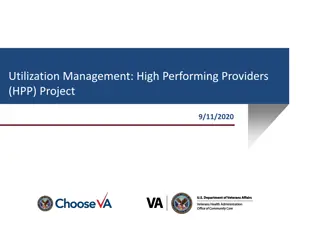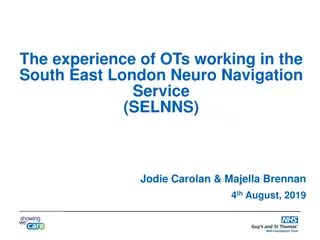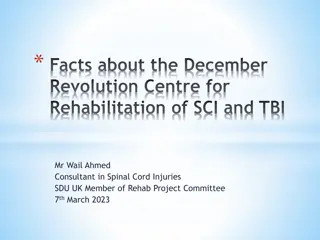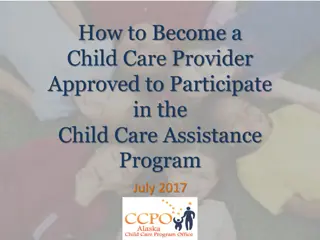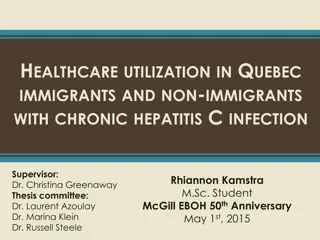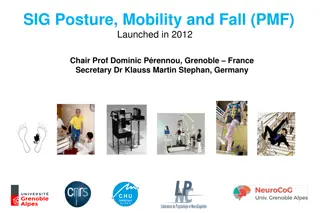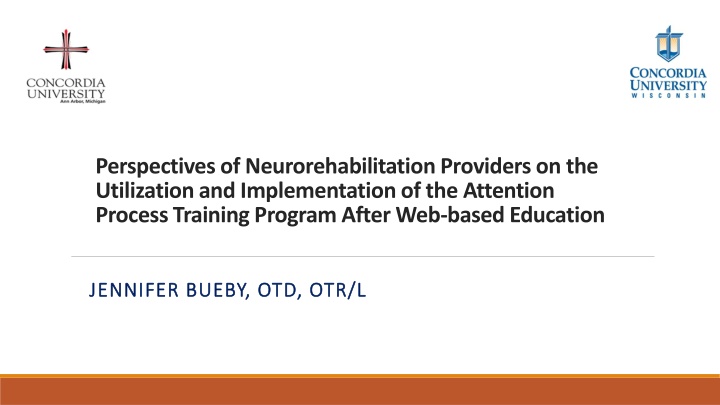
Neurorehabilitation Provider Perspectives on Attention Process Training Program Implementation
Explore the effectiveness of web-based education in enhancing neurorehabilitation providers' knowledge, skills, and confidence in implementing the Attention Process Training program. Significance to occupational therapy practice and the impact on client outcomes are discussed within the outpatient therapy clinic setting in Southeast Michigan.
Uploaded on | 3 Views
Download Presentation

Please find below an Image/Link to download the presentation.
The content on the website is provided AS IS for your information and personal use only. It may not be sold, licensed, or shared on other websites without obtaining consent from the author. If you encounter any issues during the download, it is possible that the publisher has removed the file from their server.
You are allowed to download the files provided on this website for personal or commercial use, subject to the condition that they are used lawfully. All files are the property of their respective owners.
The content on the website is provided AS IS for your information and personal use only. It may not be sold, licensed, or shared on other websites without obtaining consent from the author.
E N D
Presentation Transcript
Perspectives of Neurorehabilitation Providers on the Utilization and Implementation of the Attention Process Training Program After Web-based Education JENNIFER BUEBY, OTD, OTR/L JENNIFER BUEBY, OTD, OTR/L
Purpose To determine whether web-based education is an effective method to improve the knowledge, skills, and confidence of neurorehabilitation providers while implementing the Attention Process Training (APT) program.
Significance to OT o Two guiding documents for occupation therapy practice (OTPF-4 and Vision 2025) support and encourage appropriate identification and implementation of evidence- based practice as it helps promote well-being, improved health, and improve participation in meaningful occupations (AOTA, 2014, 2017). o It is expected that the use of evidence-based practice to improve attention skills will in turn improve client success and performance in all daily activities, which makes treatment client-centered, effective, and ethical (Lencucha, Kohari, & Rouse, 2007). o Within clinical practice, effective and accessible education is essential for improving confidence, knowledge, and skills related to the utilization of evidence-based therapies.
Setting Outpatient therapy clinic in Southeast Michigan Center for brain injury rehabilitation that offered individual sessions and a day treatment program Participants were all occupational therapy providers who delivered cognitive rehabilitation services to clients at the clinic and actively use the Attention Process Training program with patients IRB approval obtained from Chatham University in Pittsburgh, PA
Background Web-based Education o Significant improvements in knowledge and skills after web-based education is provided to health care providers (Ens, Janzen & Palmart, 2016; Hills, Robinson & Heathcote, 2010; MacNeill, Telner, Sparaggis-Agaliotis & Hanna, 2014; Maloney et al, 2011; Thomas et al., 2017). o Significant improvement in confidence for accurate implementation of a treatment approach or assessment after web-based education (Ens et al., 2016; Hills et al., 2010; Ohtake et al., 2013; Powers & Candela, 2016; Thomas et al., 2017). Attention Process Training (APT) program o Evidence-based training program made up of ~180 modules that target improvement of sustained, selective, divided, alternating, or executive attention skills at various skill levels.
Literature Review A Critical Appraisal of the Topic portfolio was compiled and included: 10 research articles Quantitative and mixed methods studies Literature with 6 countries of origin Three themes identified during the review of the literature assisted in the development of educational modules and surveys:
Design and Implementation Mixed methods data collection, one-group pretest posttest design Six educational modules were created for web-based presentations with opportunity for applied learning through implementation Researcher-developed surveys Week 1 Week 2 Week 3 Week 4 Week 5 Week 6 Intervention Pre- intervention survey Module 1 Module 2 Module 3 Module 4 Applied learning with patients Applied learning with patients Applied learning with patients Module 5 Module 6 Applied learning with patients Post- intervention survey
Design and Implementation Educational Module Content Module 1: Description of Attention Process Training (APT) program and evidence supporting the APT program as an effective treatment tool for improvement of attention skills Module 2: Description of the APT Screen Test including proper administration and implications of results Module 3: How to utilize APT Screen Test results for identification of patient-appropriate program modules and use of the Goal Attainment Scale Module 4: Proper timelines for implementation of program and programming of practice drive Module 5: Identification of occupation-based interventions that are specific to attention level of patient that may be used in conjunction with APT program and compensatory strategies Module 6: Benefits, limitations, and challenges for program implementation
Outcomes Participants reported increase in perceived confidence
Outcomes Participants demonstrated increased knowledge for frequency of module implementation The Attention Process Training program (APT) should be implemented at least twice per week as indicated by the evidence (Palmese & Raskin, 2000; Sohlberg et al., 2010).
Outcomes Participants demonstrated increased knowledge for length of program implementation The Attention Process Training program (APT) should be implemented for a total of 6-8 weeks as indicated by the evidence (Palmese & Raskin, 2000; Sohlberg et al., 2010).
Outcomes Participants demonstrated increased knowledge for hours of implementation per week The Attention Process Training program (APT) should be implemented 2-3 hours per week, as indicated by the evidence (Palmese & Raskin, 2000; Sohlberg et al., 2010).
Participants Reported New Learning Related to APT Program Outcomes Participants reported new learning related to implementation of the APT program
Summary o Neurorehabilitation providers knowledge, perceived skills, and confidence for accurate implementation of the APT program improved after web-based education. o Knowledge, skills, and confidence improve when evidence-based methods (web-based education) are utilized to educate health care providers. o Web-based education is an effective method for increasing knowledge and confidence related to implementation of evidence-based practice within occupational therapy. o Additional education may be required for OT practitioners to accurately implement evidence-based treatment approaches despite regular use within a clinic setting.
References American Occupational Therapy Association. (2020). Occupational therapy practice framework: Domain and process (4th ed.). American Journal of Occupational Therapy, 74(Suppl. 2), S1 S87. American Occupational Therapy Association. (2017). Vision 2025. American Journal of Occupational Therapy, 71, 7103420010. https://doi.org/10.5014/ajot.2017.713002 Ens, A., Janzen, K., & Palmert, M. R. (2017). Development of an online learning module to improve pediatric residents confidence and knowledge of the pubertal examination. Journal of Adolescent Health, 60(3), 292-298. https://doi.org/10.1016/j.jadohealth.2016.10.006 Hills, D. J., Robinson, T., Kelly, B., & Heathcote, S. (2010). Outcomes from the trial implementation of a multidisciplinary online learning program in rural mental health emergency care. Education for Health, 23(1). Retrieved from http://www.educationforhealth.net Lencucha, R., Kothari, A., & Rouse, M., J. (2007). The issue is-Knowledge translation: A concept for occupational therapy? American Journal of Occupational Therapy, 61, 593-596. Liaw, S. Y., Wong, L. F., Chan, S. W., Ho, J. T. Y, Mordiffi, S. Z., Ang, S. B. L., Goh, P. S. & Ang, E. N. K. (2015). Designing and evaluating an interactive multimedia web-based simulation for developing nurses competencies in acute nursing care: Randomized controlled trial. Journal of Medical Internet Research, 17(1). https://doi.org/ 10.2196/jmir.3853 Macneill, H., Telner, D., Sparaggis-Agaliotis, A., & Hanna, E. (2014). All for one and one for all: Understanding health professionals experience in individual versus collaborative online learning. Journal of Continuing Education in the Health Professions, 34(2), 102-111. https://doi.org/10.1002/chp.21226 Maloney, S., Haas, R., Keating, J.L., Molloy E., Jolly, B., Sims, J., . . . Haines, M.P. (2011). Effectiveness of web-based versus face-to-face delivery of education in prescription of falls-prevention exercise to health professionals: Randomized trial. Journal of Medical Internet Research, 13(4), 1-9. https://doi.org/10.2196/jmir.1680 Ohtake, P. J., Lazarus, M., Schillo, R., & Rosen, M. (2013). Simulation experience enhances physical therapist student confidence in managing a patient in the critical care environment. Physical Therapy, 93(2), 216-228. Palmese, C. A. & Raskin, S. A. (2000). The rehabilitation of attention in individuals with mild traumatic brain injury, using the APT-II programme. Brain Injury, 14(6), 535-548. https://doi.org/10.1080/026990500120448 Powers, K. A., & Candela, L. (2016). Family presence during resuscitation: Impact of online learning on nurses perception and self-confidence. American Journal of Critical Care, 25(4), 302-309. https://doi.org/10.4037/ajcc2016814 Sohlberg, M. M., McLaughlin, K. A., Pavese, A., Heidrich, A., & Posner, M. I. (2010). Evaluation of attention process training and brain injury education in persons with acquired brain injury. Journal of Clinical and Experimental Neuropsychology, 22(5), 656-676. https://doi.org/10.1076/1380-3395(200010)22:5;1-9;FT656 Thomas, E. M., Rybski, M. F., Apke, T. L., Kegelmeyer, D. A., & Kloos, A. D. (2017). An acute interprofessional simulation experience for occupational and physical therapy students: Key findings from a survey study. Journal of Interprofessional Care, 31(3), 317-324. https://doi.org/10.1080/13561820.2017.1280006






